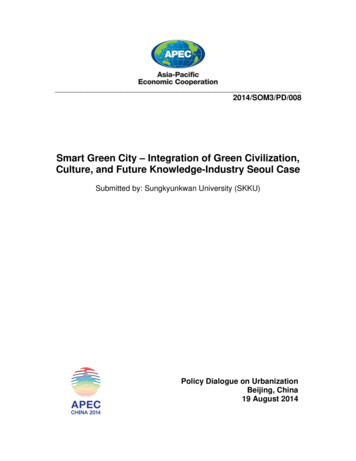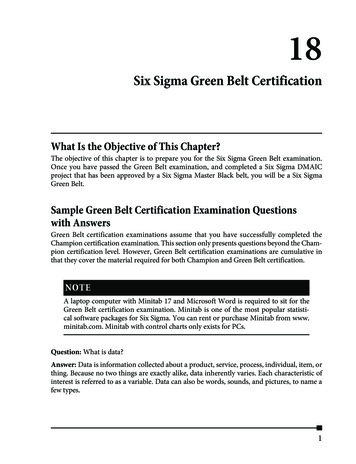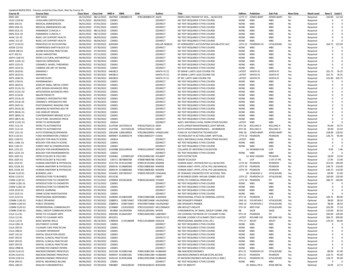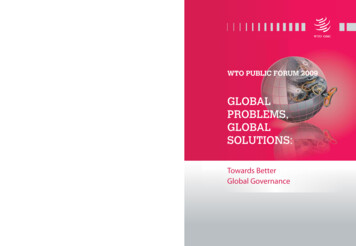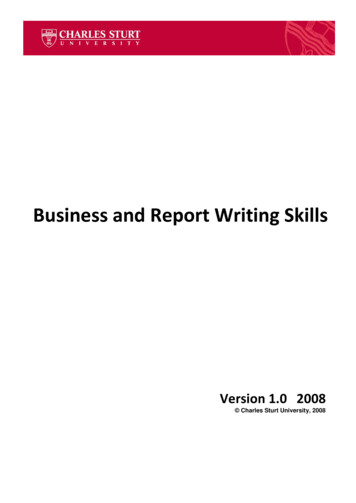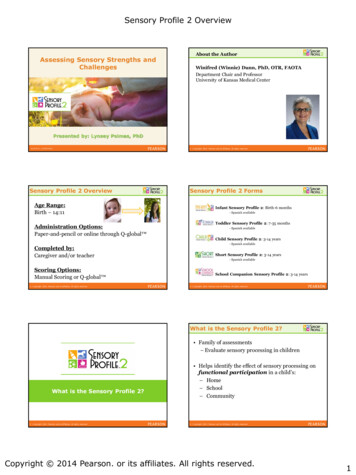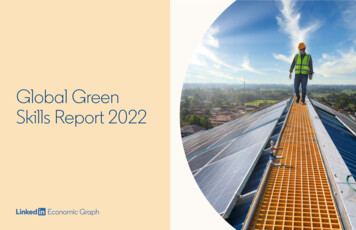
Transcription
Global GreenSkills Report 2022
Foreword by Ryan Roslansky.3Executive Summary.4Chapter One — Green Skills & Jobs.5Table ofcontentsChapter Two — Country & Sector Trends.15Chapter Three — Just Transition.29Chapter Four — Action Plan.35Appendix — Glossary.40Appendix — Methodology.42Appendix — Country annexes.452
ForewordThere is amassive shiftunderway in theglobal economy.There is a massive shift underway in the globaleconomy. In the wake of the pandemic, the worldis witnessing a historic transformation in howpeople work, why they work and where they work.At LinkedIn, we call it the Great Reshuffle, anunprecedented moment in history where we arereimagining the future of work. People are activelyacquiring new skills and pursuing new ventures.Employers are reinventing business models andcreating new markets. And all of this economicupheaval, which would normally play out over thecourse of decades, is being compressed into acouple of years.Amid this Great Reshuffle, we’re faced with anurgent need to transition our society to a greeneconomy to address the threat of climate change.How do we apply what we’ve learned from thisunprecedented moment to power the enormoustransition that needs to happen to meet theclimate crisis?Achieving our collective global climate targets is amonumental task and it is going to take a wholeof-economy effort to make it happen. That meanswe need a transformation in the skills and jobspeople have if we’re going to get there. The goodnews is that we are already seeing a shift to greenskills and jobs underway on our platform, whichhas nearly 800 million members around the world.Green talent in the workforce worldwide is rising.The share of green talent increased from 9.6% in2015, to 13.3% so far in 2021 (a growth rateof 38.5%).Jobs are a critical part of the conversation aboutachieving this green transition. And rightly so. Weexpect to see millions of new jobs created globallyin the next decade driven by new climate policiesand commitments. For example, in the last fiveyears, the number of Renewables & Environmentjobs in the U.S. has increased by 237%, in starkcontrast to the 19% increase for Oil & Gas jobs.At this pace, the Renewables & Environmentsector will outnumber Oil & Gas in total jobs onour platform by 2023.It’s more than jobs — we need to zoom in onthe skills that power these jobs. Green skills. Webelieve real change will come through a skillsbased approach to opportunity. We have seendouble-digit growth across dozens of greenskills over the last five years. The fastest-growinggreen skills are in Ecosystem Management,Environmental Policy and Pollution Prevention.But the vast majority of green skills are beingused in jobs that aren’t traditionally thought of asgreen — such as fleet managers, data scientists orhealth workers.Governments, companies, and individuals allneed to come together to help transition thehiring market from focusing solely on titles andcompanies, degrees and schools, to also focusingon skills and abilities. We want to be a catalystfor job and skill transformations, and we have thetools to help.This green skills report is one way we’re doing ourpart. We leverage our unique data and labourmarket expertise to highlight actionable insightsthat are crucial to delivering a successful greentransition and avoiding potential pitfalls.I’m excited about this work and the ability toeducate, inform and enable policy and investmentdecisions that will accelerate our transition to thegreen economy. LinkedIn is committed to tacklingthe climate change challenge. There is no moreurgent one.Ryan RoslanskyCEO, LinkedIn3
Executive SummaryIf we’re to deliverreal change, wehave to thinkabout green rolesand green skills.At the heart of it is people. Greening the economyis a human capital issue.We’ve looked at our unique global data, analysedit as only LinkedIn can, and have identified thatif we’re to deliver real change, we have to thinkabout green roles and green skills.Green skills are a critical factor in realising thesuccess and speed of the green transition. Ourdata shows hiring for green skill talent is risingglobally but nowhere near what’s needed. Inaddition to diagnosing where we need to makemore progress, we provide recommendations onhow to close the green skills gap, upskill workersand enable the shift to more green jobs.This report provides new data on green skillsand jobs from all across the world, to empowerpolicymakers, governments and business leaderswith actionable insights to help them transition theglobal workforce to a green economy future.We also analyse differences in the green transitionfor each country and sector, including howcorporate services, manufacturing, energy andmining, public administration and construction arethe sectors with the highest intensity of green skillsglobally. Every featured country shows green skillsin at least one sector, but as economies greenup, some regions are creating green jobs acrossmultiple sectors more than others.We need to ensure that this transition is a justand inclusive one, as well as a sustainable one.We examine the gaps that exist across income,gender and education levels, and providerecommendations for actions that governments,organisations and individuals can take.We can meet this challenge by working togetherand learning from each other. Let’s get to work.4
Chapter OneGreen Skills& Jobs5
Chapter One: Green Skills & JobsGreen skills and jobs are urgentlyneeded to power the green transition.We’re in a time of great upheavalaround the world. We are experiencingan unprecedented moment in historywhere we are reimagining the futureof work. Governments are assessingpolicies, programmes and how to supportconstituents amid the pandemic. Businessleaders are reimagining their entire workingmodels, cultures and company values.Employees are rethinking what they do,where they do it and what it means.At LinkedIn, we call this the Great Reshuffle.The Great Reshuffle presents us with anopportunity. We can harness this momentof change to redirect human talent to rise tothe most urgent challenge facing humanity:the green transition. We cannot wait anylonger to address climate change. We haveto green the economy and activate the jobs,companies and policies that will power it.By capitalising on this unprecedentedDefinitionsmoment of change to redirect humantalent to accelerate the green transition,we’ll have a fighting chance of meetingthe climate challenge. But achieving thisrequires moving toward an economy thattransitions workers into jobs beyond thosecurrently considered green. New workersneed to enter green and greening potentialjobs, bolstered by green skills and moreopportunities from employers.Green skills: are those that enable theenvironmental sustainability of economicactivitiesThe hard truth is that right now we arenowhere close to having sufficient greentalent, green skills or green jobs to deliverthe green transition. Based on the currenttrajectory of green skills growth in the labourmarket, we are not going to have sufficienthuman capital to meet our climate targets.While more workers are transitioning intogreen and greening jobs than are leaving,the total number of workers transitioninginto those jobs is still really low. Not all jobsGreening potential jobs: can beperformed without green skills, butoccasionally require some level ofgreen skillsGreen jobs: are those that cannot beperformed without extensive knowledgeof green skillsGreening jobs: can be performedwithout green skills, but typically requiresome green skillsNon-green jobs: are those that do notrequire green skills to be performedGreen talent: a LinkedIn member whohas explicitly added green skills to theirprofile and/or are working in a green orgreening job6
Chapter One: Green Skills & Jobswill need to be exclusively green — it’s notjust those building solar panels — it's thesustainable fashion manufacturer, the fleetmanager, the sales manager. There is amarked lack of green skills and jobs, andthis is slowing the rate at which we cangreen the economy.Green skills intensity needs to increase inevery sector and country to build the supplyneeded and meet the demand required toachieve climate goals. Some progress hasbeen made. In 2019, the balance tippedtowards green talent as the green hiringrate accelerated ahead of the overallhiring rate in most economies around theworld. This means that, globally, greenworkers were hired at a higher rate thannon-green workers. At the same time, theshare of green talent in the global workforceincreased from 9.6% in 2015 to 13.3% so farin 2021 (an annual growth rate of 6% and acumulative growth rate of 38%).Why Green SkillsGreen skills are the building blocks of thegreen transition and the key to unlockingthe human capital that will power it. Weneed more opportunities for those withgreen skills. We have to upskill workerswho currently lack those skills. And weneed to ensure green skills are hardwiredinto the skillset of future generations.Green-skilling is needed to fuel greenerjobs. To measure the current status andthe recent evolution of green skills, weuse LinkedIn’s new green skill taxonomyto quantify the extent to which differentcountries, sectors and jobs use theseskills. We call this green skill intensity.7
Chapter One: Green Skills & JobsWe have not made enough progress, especiallywhen it comes to equipping workers with the greenskills they need to meet this growing demand.Growth in the demand for workers with green skillshas outpaced the growth in the supply of greentalent. While job postings requiring green skillsgrew at 8% annually over the past five years, theshare of green talent has grown at roughly 6%annually in the same period. This is a significantmissed opportunity for the planet and for workers— one that we can begin to address immediately.the Share of Hiring (2016 1)Chart 1: Change in the share of global hiring by job typeData indexed to 2016 hiring levelsChange in the Share of Hiring (2016 1)Along with green skills intensity, green or greeningjobs are the catalyst for real-world change. Greenjobs are occupations that cannot be performedwithout extensive knowledge of green skills.Importantly, greening or greening potential jobsare those that could be performed without greenskills, but typically require some level of green skills.Chart 1 shows the growth in the hiring of greenjobs, and that the hiring of green jobs in theglobal workforce is rising. Yet, together green andgreening jobs still only account for 10% of hiringin 2021, while non-green jobs dominate at 50% of1.2hiring (Chart 3). The share of hiring for greeningand greening potential jobs is stagnating ordeclining, while the share of non-green jobs is1.1still growing.While job postings requiring green skillsgrew at 8% annually over the past fiveyears, the share of green talent has grownat roughly 6% annually in the same ningGreening PotentialNot Green81
Chapter One: Green Skills & JobsMost jobs requiring green skillsare not traditional green jobs.We have a historical opportunity to rethinkhow we approach the global workforce’stransition into a greener economy, basedon skills. By adding insights from new datato this challenge, we can make a plan toincrease green skills intensity around theworld. The workforce is ready and the planetcan’t wait: the time is now.Chart 2: Fastest-growing green and greening jobs globally40%Medium term: Job Growth (2016–2021)Chart 2 shows that the top five fastestgrowing green jobs between 2016 and 2021,in terms of annual growth, are SustainabilityManager (30%), Wind Turbine Technician(24%), Solar Consultant (23%), Ecologist(22%), and Environmental Health and SafetySpecialist (20%). The fastest-growing greeningjobs, moreover, are less specialised and arefound in a variety of sectors — including rolesthat range from Compliance Manager (19%)to Facilities Manager (11%) and TechnicalSales Representative (8%).Sustainability Manager30%Wind Turbine TechnicianCompliance ManagerEcologistSolar Consultant20%Geotechnical EngineerRisk AdvisorProgrammeSafety TechnicianManagerEnvironmental Health Safety SpecialistRegulatory Affairs ConsultantFarm Manager10%Construction ManagerFacilitiesManagerTechnical Sales Representative0%0%10%20%30%40%50%60%70%80%90%Short term: Job Growth (2020–2021)Bubble size indicates share of countries in the sample where the job was among the fastest-growing in 2016–2021.Smallest: 5%; Largest: 50%. Bubble shade indicates type of job. Dark: Green job; Light: Greening job.9
Chapter One: Green Skills & JobsFive trends shaping the green economyTrend 1Demand for green talent willsoon outpace supply.In the past year, 10% of job postings requiring skills haveexplicitly required at least one green skill — which isgenerally aligned with 10% of the hires in the same periodgoing to green or greening jobs (Chart 3). However, whilejob postings requiring green skills grew at 8% annually overthe past five years, the share of green talent has grown atroughly 6% annually in the same period.Chart 3: Share of 2021 Hiring, by job type (2021)50%1%Green (1%)9%Greening (9%)40%Greening Potential (40%)Not Green (50%)30%50%20%40%10%0%10
Chapter One: Green Skills & JobsFive trends shaping the green economyHiring of green talent is acceleratingfaster than overall hiring.In 2019, the hiring balance tipped towards green talent,as the green hiring rate accelerated ahead of the overallhiring rate in most economies around the world (Chart 4).This means that, globally, green workers were hired at ahigher rate than non-green workers. The pandemic hasaccelerated this trend, which suggests that green talenthas been relatively more resilient to an economic downturnthan non-green talent.Chart 4: Relative Green Hiring Rate, global1.2Green LHR/LHR (1 Rates are equal)Trend 2Green LHR above Overall LHR1.0Green LHR below Overall elative green LHR (Green LHR to General LHR)11
Chapter One: Green Skills & JobsFive trends shaping the green economyTrend 3There’s currently a good balance inthe green skills that are needed.Currently, there is a relatively good balance in the supply anddemand of green skills. Half of the top 10 in-demand greenskills match the most popular skills among the green workforce(Tables 1 and 2), including Sustainability, Renewable Energy,Environmental Awareness, Environment, Health and Safety(EHS), and Corporate Social Responsibility.Table 1: Top in-demand green skills required by employers (2021)Table 2: Top green skills added by members (2021)Skill nameGreen skill categorySustainabilitySustainable DevelopmentRemediationEnvironmental RemediationOccupational Safety and HealthAdvisor (OSHA)Share of job postingsrequiring the skill(out of job postingsrequiring any green skill)Share of memberswho added the skill(out of membersadding any skill)Skill nameGreen skill categorySustainabilitySustainable Development12.6%8.8%Environmental AwarenessEcosystem Management10.0%Environmental Policy8.6%Renewable EnergyRenewable Energy Generation9.2%ClimateEcosystem Management5.6%Environment, Health and Safety (EHS)Environmental Auditing5.9%Renewable EnergyRenewable EnergyGeneration5.4%Sustainable DevelopmentSustainable Development5.3%Environmental AwarenessEcosystem Management4.9%Sustainable DesignPollution Prevention5.1%Environment, Health and Safety (EHS)Environmental Auditing3.7%Environmental ScienceSustainability Research4.7%Solar EnergyRenewable EnergyGeneration2.6%ISO 14001Environmental Policy4.2%Corporate Social ResponsibilityEnvironmental Policy2.5%Environmental Management SystemsEnvironmental Auditing4.1%RecyclingEnvironmental Remediation2.1%Corporate Social ResponsibilityEnvironmental Policy4.1%27.6%12
Chapter One: Green Skills & JobsFive trends shaping the green economyTrend 4The fastest growing green skills areboth mainstream and emerging.Some skills in high employer demand that show relativelylower prevalence in the workforce, are Remediation,Recycling, OSHA, Climate and Solar Energy — but the lastthree listed are among the fastest growing skills in 2016–2020.And several of the fastest growing green skills across allsectors during the same time period were not necessarilyin-demand skills, but suggest the emergence of new trends,including Sustainable Fashion, Oil Spill Response andSustainable Business Strategies, among others (Table 3).Table 3: Fastest-growing green skills (2016–2021)Skill nameGreen skill categorySkill growthSustainable fashionPollution Prevention90.6%Environmental servicesEcosystem Management82.5%Oil spill responseEnvironmental Remediation80.4%ClimateEcosystem Management68.7%Sustainable GrowthEnvironmental Auditing67.2%Surface waterEcosystem Management64.5%Occupational Safety and HealthAdvisor (OSHA)Environmental Policy57.9%Sustainable business strategiesPollution Prevention56.6%Solar systemsRenewable Energy Generation55.5%Sustainable landscapesEcosystem Management52.9%13
Chapter One: Green Skills & JobsFive trends shaping the green economyTrend 5The volume of workers moving into greenand greening jobs is too low.Workers are increasingly acquiring green skills and transitioninginto green and greening jobs, resulting in positive net transitionsinto these jobs (Chart 5). However, on aggregate, the volume oftransitions into green and greening roles is still too low to have atransformative impact by itself (Chart 6).Chart 6: Global job transitions among different types of jobs ingPotentialGreeningPotentialChart 5: Global Net Job Transitions: Ratio of workers transitioninginto a job type vs. those transitioning out (2016–2021)Net transitions Greening PotentialAt 1 the number of workers transitioning into a job type equal thenumber of workers transitioning out of that job type.NotGreenNot Green14
Chapter TwoCountry &Sector Trends15
Chapter Two: Country & Sector TrendsCurrent green talent will not meetthe demand for green jobs.Looking at the spread of talent aroundthe world and within sectors throughthe lens of green skills, we can seeclearly that the demand for green talentand green skills is outpacing supply.The impact of the green transition hasreverberated throughout all sectorsand countries across the globe —with not one left unchanged. Ourinsights not only highlight the scaleof the challenge, but shine a light onthe path forward. We can empowerpolicymakers and business leaderswith specific insights across sectors andcountries, outlining the needs of theworkforce and what skills are required.We’re seeing early trends in how greenskilling is playing out, especially withinindustries and geographies that havetraditionally focused on high-emissionjobs. Indications are that workers areupskilling to green their jobs. The dataalso shows that sectors in differentcountries are attracting green skills atvarying paces. Green skills intensityneeds to increase in every sector andcountry to build the supply needed andmeet the demand required to achieveclimate goals.Chart 7: Relative green skill intensity by sectorCorporate ServicesManufacturingEnergy & MiningPublic onNonprofitAt the right of the line:Above global averageConsumer GoodsHealthcareReal EstateTransportation & LogisticsRecreation & TravelChart 7 on green skills intensity acrosssectors shows that corporate services,manufacturing, energy and mining,public administration, and constructionare the sectors that use the highestnumber of green skills across the globe.Software & IT ServicesPublic SafetyFinanceRetailHardware & NetworkingMedia & CommunicationsWellness & FitnessEntertainmentLegalArts0123Relative Green Skills Intensity ( 1 global average)16
Chapter Two: Country & Sector TrendsChart 8: Top 25 countries with the higher number of sectors with green skills (2021)United StatesUnited KingdomUnited Arab EmiratesTurkeySwitzerlandSwedenSpainSouth AfricaSaudi ndiaGreeceGermanyBelow global averageFranceColombiaChileCanadaBrazilSectorAbove global averageAustraliaGreen skill intensity:ArgentinaThis said, there is variation across countries— of the top 25 countries with the highestnumber of sectors with green skills, differentcountries concentrate on different sectors(Chart 8).AgricultureArtsConstructionConsumer GoodsCorporate ServicesDesignEducationEnergy & hcareLegalManufacturingMedia & CommsNonprofitPublic AdminPublic SafetyReal EstateRecreation & TravelRetailSoftware & IT ServicesTransp. & LogisticsWellness & Fitness17
Chapter Two: Country & Sector TrendsNot only does the intensity of green skillsvary by country and sector, but Table 4shows how workers’ job transitions aretrending differently across sectors. In linewith the global trend, most sectors aretrending positive for the moment. However,there are five sectors showing unclear ornegative trends.Table 4: Sector trends in job transitionsGreen transition trendSectorsTrendsLeading AgricultureCorporate ServicesDesignEnergy & MiningManufacturingPublic AdministrationWith an above-average green skill intensity, workers inthese sectors are increasingly showing transitions intogreen/greening jobs. For every 100 workers transitioninginto non-green jobs, up to 256 workers transition intogreen/greening jobs.Trending positive ArtsConsumer GoodsEntertainmentFinanceHealthcareLegalMedia & CommunicationsReal EstateRecreation & TravelRetailSoftware & IT ServicesTransportation & LogisticsWellness & FitnessThese sectors have a below-average green skill intensity,but workers are transitioning into green/greening jobsfaster than workers in non-green jobs are transitioninginto green/greening. For every 100 workers going intonon-green jobs, up to 477 workers transition into green/greening jobs.Unclear Hardware & Networking Non-profit Organisations Public SafetyPerforming below the average green skill intensity, thesesectors are not showing major shifts in job transitions.Trending negative Construction EducationThese sectors show an above-average green skill intensity, but workers are transitioning out of green/greeningjobs at a faster rate than workers in non-green jobs aretransitioning into green/greening. In fact, for every 100workers transitioning into non-green jobs, as little as 47workers transition into green/greening jobs.18
Chapter Two: Country & Sector TrendsAs countries go green,job opportunities emerge.Green skills intensity is a helpful metricto understand how workers in differentcountries are applying green skills in theirjobs. As Chart 9 on green skills intensityacross countries shows, the average jobin the United States, United Kingdom andAustralia uses roughly two to three timesmore green skills than the averagejob globally.This is the moment to turn to urgent climateaction — good for the planet and good forworkers. More jobs, more opportunities,even in times of global crisis. The pandemichas shown that green talent can be moreresilient than non-green talent. Each regionand sector must turn attention to more greenskills and jobs in every corner of the world,to power the urgent transition.Chart 9: Relative green skill intensity by country (Top 25)United StatesUnited KingdomAustraliaCanadaIndiaBrazilItalySouth AfricaSpainSwedenIndonesiaUnited Arab EmiratesFranceGermanySaudi ArabiaFinlandTurkeyNetherlandsGreeceNew ZealandAt the right of the line:Above global tive Green Skills Intensity ( 1 Global Average)19
Case StudySpotlight20
Case Study SpotlightExploring unique trends in the green transitionLinkedIn data makes it clear that we needto act quickly and boldly, and it showswhich areas require the most urgentattention. These insights are designed tohelp policymakers and business leadersmake evidence-based, focused decisionsabout the green transition. Below arefive case studies that complement theseinsights. They have been selected toillustrate the opportunities and successesof sectors and regions around the world inrising to the climate challenge.We applied a global lens to both atraditional and new industry and zoomedin on three success stories in three differentregions to showcase how the growth ingreen skills intensity is powering positivechange: Sustainable Fashion, while still a nicheskill, was one of the fastest growinggreen skills globally in 2016–2020,with an average annual growth rate of90.6%. This new trend demonstrates howan industry that has been around forthousands of years can make the shiftto green. Green Entrepreneurship is blossomingacross multiple industries. We needgreen innovators and entrepreneursto bring their best new thinking tomarket; new ideas, new businessmodels and new technologies. GreenEntrepreneurship is on the rise andgrowing even faster than overallEntrepreneurship in the U.S.and worldwide. In the last five years, the number ofRenewables & Environment jobs in theU.S. has increased by 237% in starkcontrast to the 19% increase for Oil & Gasjobs. At this pace, we are predicting thatthe Renewables & Environment sectorwill outnumber Oil & Gas in total jobs onour platform by 2023. The need for innovative solutions toemissions reduction has influenced rapidtechnological change in the Europeanautomotive industry. LinkedIn datashows that the share of green talent hasbeen increasing by 11.3% annually forthe past five years — exhibiting one ofthe highest growth rates in green talentamongst all manufacturing sectors. In the Asia-Pacific, 47% of the total landarea is agricultural and the regionhas a high concentration of countrieswith high green skills intensity inagriculture. Current trends in fourcountries — Australia, New Zealand,India, Singapore — show positive signsacross the sector. This trend points tothe potential of reducing emissions ina sector that is critical to achieving ourclimate targets.21
Case Study 1The eco-awakening in fashionis showing in the workforce.The global pandemic has heightenedawareness of environmental andsustainability issues, and this trendis also showing up in the talent data.LinkedIn data shows that SustainableFashion was the fastest-growing greenskill globally ( 90.6% on average between2016–2020). And traditional fashion jobs,such as fashion designers, stylists andmerchandisers, are increasingly applyingSustainable Fashion skills.A broader set of jobs, beyond thosetypical of the Apparel and Fashionindustry, are applying green skills. Beyondthe traditional jobs, workers skilled inSustainable Fashion are also activeacross many other industries, such asmedia and communications, design, arts,manufacturing, corporate services, nonprofit organisations, and software andIT services.Talent in the Apparel and Fashionindustry is becoming greener, not onlyin fashion design hubs but also acrossmanufacturing hubs. The share of greentalent in the Apparel and Fashion industryhas increased consistently at the globallevel since 2015. Table 5 shows that intraditional design hubs — predominantlylocated in Europe and North America —the share of green talent grew at 5.8% and4.4% annually in 2015–2021, respectively.In manufacturing hubs — predominantlyin Asia — the share of green talent grew by5.9% in the same period.Table 5: Growth of green talent in Apparel and FashionContinentCompounded Annual Growth(2015–2021)AsiaEuropeNorth America5.9%5.8%4.4%Key Takeaway:Applying green skills across all sectors,especially those that produce highemissions, has the potential to acceleratethe green transition while creating newjobs globally.22
Case Study 2Green entrepreneurs are innovatingglobally and across sectors.Chart 10: Global growth in entrepreneursAnnual Growth in entrepreneurs per 1M LinkedIn members (%)Green Entrepreneurship is nascent,but growing at a faster rate thanoverall entrepreneurship. As has beendemonstrated throughout this report, weneed green skills to permeate all industriesand all sectors of the economy if we are tomeet the climate challenge. But that’s notall we need. We also need new ideas, newbusiness models and new technologies.That means we need green innovatorsand entrepreneurs to bring their best newthinking to market, to power even morechange. Green Entrepreneurship is on therise, and growing even faster than overallEntrepreneurship in the U.S. and worldwide(Chart 10). While still niche, the share ofentrepreneurs adding green skills to theirprofiles increased from 2% in 2016 to 3%in 2021, globally. Top skills being addedby founders in this field are Sustainability,Renewable Energy and Sustainable 7201820192020Green Entrepreneurs per 1M membersAll Entrepreneurs per 1M members23
Case Study 2Green entrepreneurs are innovatingglobally and across sectors.The vast majority of green entrepreneurialactivity is now happening outside oftraditionally green sectors. The sectorsseeing the highest entrepreneurial activityamongst green founders — beyondEnvironmental Services and Environment &Renewables — are Software, Architecture,Design and Finance.Europe and North America are leadingthe way, but emerging economies arecatching up: 2.5% of Brazil’s startups work withEnvir
the skills that power these jobs. Green skills. We believe real change will come through a skills-based approach to opportunity. We have seen double-digit growth across dozens of green skills over the last five years. The fastest-growing green skills are in Ecosystem Management, Environmental Policy and Pollution Prevention.


